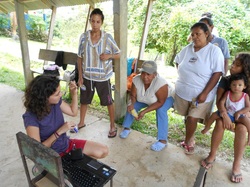This is my first season with Panacetacea working as a field intern for the 2015 Humpback Survey in the Gulf of Chiriqui. We have made it to Isla Secas, our home base for the research project. Our goal is to complete 25 boat days where we venture out through the archipelagos in search of Humpbacks in their breeding grounds. The Gulf of Chiriqui is a unique breeding ground due to the fact that whales from both the Northern and Southern Hemisphere migrate to these waters. Going out in the boat and capturing photo I.D.'s of the whale's fluke is how we identify individual whales, they act like a fingerprint for each whale. Through collaboration with photo I.D. records from Humpback feeding grounds, we are able to determine where the whales we see here have come from. This information has important implications in understanding Humpback behavior and helps protect and conserve the species as a whole.
This season is off to a strong start; on our way out to the island, not even a full boat day, we saw bottlenose and spotted dolphins as well as 12 Humpbacks! I don't think I have seen a Humpback whale since I was 14 in Bar Harbor Maine, but it is always a special experience. Our first encounter was uniquely special, however. We found a mom and her newborn calf as well as three large male escorts. The mother was simultaneously supporting the calf, who needed help swimming, while keeping it safe from the three males. All of the whales stayed close to the surface for about 45 minutes allowing us to get great photos and even some video of the mother and calf swimming together. This felt different than my last whale watch, like we were observing the whale's natural behavior in a tense moment for a mother and her newborn. It was an exciting start to my work with Panacetacea and I am very excited for a productive field season.



